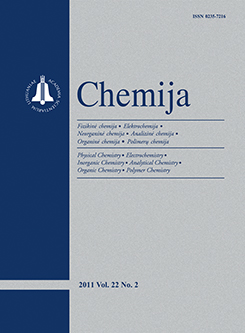Chemija / Chemistry
 ISSN 0235-7216 ISSN 2424-4538 (online) |
2014 m. Nr. 1 Vynuogių antioksidacinio aktyvumo ryšys su jų spalva
Fruits of the vine and their products, including wine, are the raw material, which is a valuable source of biologically active substances for the human organism. The most important group of health-promoting compounds present in fruits are polyphenols, flavonoids, phenolic acids, flavones, flavonols, flavanones, flavanonols, catechins, and anthocyanin pigments. The aim of the present study was to determine the level of selected secondary metabolites and the antioxidant capacity of vine fruits depending on their colouring. The experimental material consisted of fruits derived from three vine cultivars characterized by different skin colouring: ‘Regent’ – dark blue fruits, ‘Einset Seedless’ – pink fruits, and ‘Jutrzenka’ – white fruits. A field experiment was conducted in 2010 and 2011 in Vineyard Faliszowice in Sandomierz Upland (50°39’N; 21°34’E). Shrubs of three cultivars were planted in spring 2003. The harvest was dependent on the results of sugar content measurements in grape extract using an Abbe refractometer. Fruits of the studied cultivars were subject to a comparative analysis of the content of secondary metabolites such as: total polyphenols, gallic acid, phenolic acids, flavonoids, tannins and anthocyanins. The results showed that the antioxidant activity of the studied grapes depended significantly on the colour of berries; fruits of ‘Regent’ and ‘Einset Seedless’ cv. had a significantly higher antioxidant capacity than the ‘Jutrzenka’ cv. It has been shown that contents of anthocyanins and flavonoids increased along with increasing colour intensity of grapes. Fruits of ‘Einset Seedless’ cv. having pink-coloured skin contained significantly more phenolic acids and tannins than the others.
Keywords: vine, extract, polyphenols, anthocyanins, flavonoids, tannins |
Issues:
2017 - Vol.28 No. 1, No. 2, No. 3, No. 4 2016 - Vol.27 No. 1, No. 2, No. 3, No. 4 2015 - Vol.26 No. 1, No. 2, No. 3, No. 4 2014 - Vol.25 No. 1, No. 2, No. 3, No. 4 2013 - Vol.24 No. 1, No. 2, No. 3, No. 4 2012 - Vol.23 No. 1, No. 2, No. 3, No. 4 2011 - Vol.22 No. 1, No. 2, No. 3, No. 4 2010 - Vol.21 No. 1, No. 2-4 2009 - Vol.20 No. 1, No. 2, No. 3, No. 4 2008 - Vol.19 No. 1, No. 2, No. 3-4 2007 - Vol.18 No. 1, No. 2, No. 3, No. 4 2006 - Vol.17 No. 1, No. 2-3, No. 4 2005 - Vol.16 No. 1, No. 2, No. 3-4 2004 - Vol.15 No. 1, No. 2, No. 3, No. 4 2003 - Vol.14 No. 1, No. 2, No. 3, No. 4 2002 - Vol.13 No. 1, No. 2, No. 3, No. 4 2001 - Vol.12 No. 1, No. 2, No. 3, No. 4 |